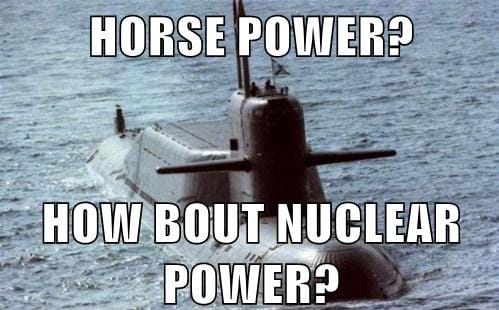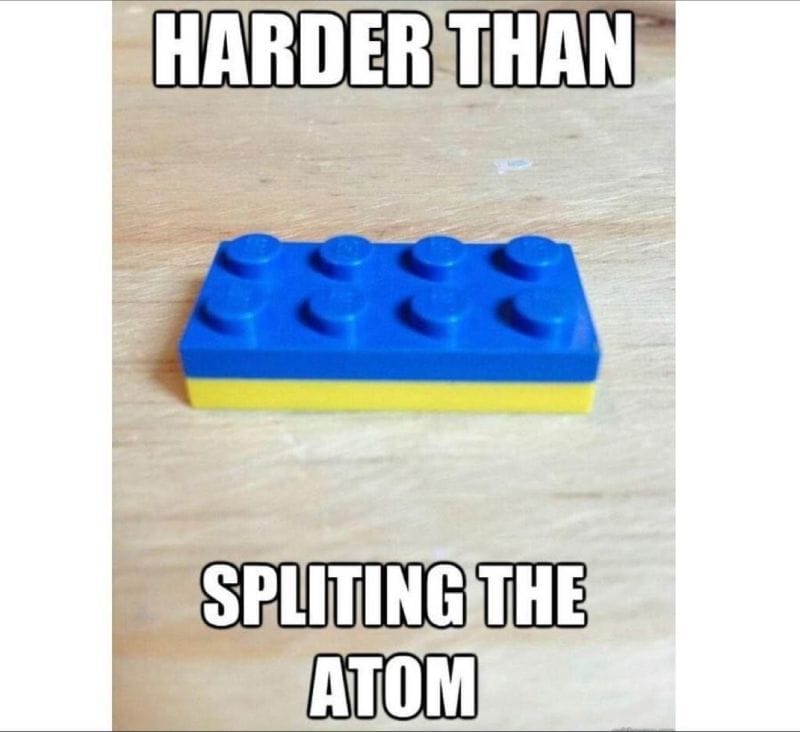- Nuclear Update
- Posts
- ⚛️Small Modular Reactors Explained: What SMRs Mean for the Future of Nuclear
⚛️Small Modular Reactors Explained: What SMRs Mean for the Future of Nuclear
They’re modular, they’re mighty, and they might change nuclear forever.

Welcome to Nuclear Update, the newsletter emitting charm like gamma rays.
With the nuclear news cycle running on vacation hours, it is the perfect week to dig into something big in a small package: Small Modular Reactors. They are hyped, they are ambitious, and if they work as advertised, they could reshape how nuclear gets built.
And yes, because I cannot help myself, I’ve sprinkled in a few memes and puns to keep things lively while we talk megawatts.
But First: This week’s trivia question:
Which country operates the largest fleet of nuclear-powered vessels, including submarines and aircraft carriers? |
Last week, I asked: Which scientist was the first to split the atom?
You said:
🟨🟨🟨🟨🟨🟨 Robert Oppenheimer (42%)
🟨🟨⬜️⬜️⬜️⬜️ Marie Curie (15%)
⬜️⬜️⬜️⬜️⬜️⬜️ Albert Einstein (5%)
🟩🟩🟩🟩🟩⬜️ Ernest Rutherford (38%)
Now, let’s dive into the good stuff!💥

⚛️Small Modular Reactors Explained: What SMRs Mean for the Future of Nuclear
Small Modular Reactors have moved well beyond just buzz. According to the Nuclear Energy Agency (NEA), around 74 SMR designs are now actively in development around the globe.
Consulting firm Mackenzie tracks roughly 22 GW of future SMR capacity in the pipeline, equating to nearly $176 billion in potential investment, a 65% jump since 2021.
Meanwhile, the NEA’s dashboard shows 51 designs currently in pre-licensing or licensing phases across fifteen countries, and about 85 active discussions underway between developers and site owners.

Map of SMR sites. Source: Nuclear Energy Agency
Despite all that ambition, only a handful of SMRs are actually operating today, mostly state-run or demonstration projects in Russia and China.
📜First Things First
“SMR” stands for Small Modular Reactor. The usual definition, used by the IAEA and World Nuclear Association, is any reactor producing up to about 300 MW electric per module. Some designs aim higher, but 300 MWe is the common cut-off.
That said, there is no single, globally binding definition. “SMR” has become a convenient catch-all for any small, factory-built reactor.
In recent years, it has also turned into a bit of a buzzword, used to imply “smaller, safer, more flexible, better”, and many designs are already on path to proving that true.
📅A Quick Look Back
The concept has been floating around for decades, but it broke into mainstream nuclear chatter in the early 2010s.
U.S. Energy Secretary Steven Chu called SMRs “America’s new nuclear option,” pitching them as cheaper, faster builds that could be slotted in like giant Lego bricks.
Of course, the “small nuclear reactor” idea is not new at all. Navies have been using compact pressurized water reactors to power submarines and aircraft carriers since the 1950s.
The U.S., U.K., France, Russia, and China all run nuclear-powered vessels, with reactors designed to operate for years without refueling.

These naval units are technically SMRs by size and output, but they are optimized for endurance, stealth, and mobility rather than low cost or mass production.
That experience is one reason proponents say SMRs are not an untested fantasy. The technology to build small, reliable reactors has existed for decades.
The challenge now is scaling it for civilian use at an affordable price.
That’s why the “modular“ part matters (no pun intended).
🏗️Why “Modular” Matters
SMRs are built in factories, shipped in sections, and assembled on site.
The idea is to repeat the same design over and over, cutting costs and timelines through standardization.

That’s a big contrast to conventional gigawatt-scale plants, which are essentially one-off mega-projects. Each is a custom build with unique site conditions, local regulations, and supply chain quirks.
This means every project has to reinvent the wheel, often while dealing with shifting political winds, regulatory changes midstream, and a global shortage of skilled nuclear welders and engineers.
Add in financing delays, contractor disputes, and the occasional headline-grabbing policy reversal, and it’s no wonder traditional builds frequently run years late and billions over budget.
SMRs aim to sidestep much of that chaos by moving the complexity into a controlled manufacturing environment, leaving only the simpler assembly work for the field.
This approach does not just make construction smoother, it can also make licensing and regulatory approvals less painful. A standardized design can be reviewed and certified once, then replicated across multiple sites without regulators having to start from scratch each time. That means fewer surprises, fewer delays, and less scope creep eating into budgets.
It is quite brilliant, actually. Once a site is approved and prepared, some SMR developers claim they can go from breaking ground to generating power in as little as 18 months.
In theory, that speed could change the economics of nuclear entirely, allowing utilities to add capacity almost on demand instead of committing to a decade-long build.
Of course, “in theory” is doing some heavy lifting there. No SMR has yet proven it can meet that timeline in the wild, but if even a handful get close, it could make nuclear far more competitive in fast-changing energy markets.

🌍Flexible Deployment
Because SMRs are small, they can be deployed in places where a full-scale gigawatt plant would never fit, or make sense.
Remote mining operations, island grids, Arctic communities, or industrial sites with constant high heat or power needs could all host a reactor without having to overhaul their entire energy infrastructure.
Some designs are intended to be mobile or semi-mobile, making them useful for disaster relief or military forward bases where power reliability is critical. (These are more like microreactors, and deserves its own spotlight in a future edition)
This flexibility is one of the big reasons nuclear is attracting attention from not only governments and utilities, but private companies and investors also.
Nuclear is no longer just big and central, but tailored, distributed, and adaptable to very different markets and geographies.
🚀Where We Are Right Now
The SMR world is buzzing. Here’s a look at six of the most visible SMR designs gaining real attention:
NuScale VOYGR (U.S.)
The first SMR to receive U.S. NRC certification. Each module produces 77 MWe, and the system scales up to 12 modules in one plant. It uses familiar pressurized water reactor technology but shrinks it down and stamps it out via factory production.
Oklo Aurora (U.S.)
A fast reactor running on liquid metal coolant and metallic fuel. This compact design offers 15 to 75 MWe; the company is aiming for its first build at Idaho National Laboratory by 2027. It is designed to run for up to ten years without refueling and may even recycle used fuel.
GE Hitachi BWRX-300 (U.S./Japan)
Based on GE’s proven boiling water reactor family, this 300 MWe variant boasts passive safety and natural circulation cooling. Ontario Power Generation plans to deploy it at Darlington by 2029, and deployment talks are underway across Europe and the U.S.
Rolls-Royce SMR (UK)
This 470 MWe pressurized water reactor is on the larger side of “small” but is factory-fabricated in modules for faster on-site assembly. Rolls-Royce is pitching it as a fleet solution for the UK and export markets. The UK government has committed significant funding to push it toward deployment in the early 2030s.
HTR-PM (China)
A high-temperature gas-cooled reactor using pebble-bed fuel and helium coolant. Each twin-module setup produces 210 MWe. Located at Shidaowan, it became the world’s first commercial SMR to enter operation in late 2023, offering high efficiency and inherent safety features.
If you believe in SMRs but are not sure which companies could come out ahead, that is exactly what we cover in Nuclear Update Premium. We spend tens of hours every week researching the market to find the best companies for our Premium Portfolio, breaking down the players, technologies, and contracts that separate the winners from the also-rans.
⚡Big, Small, and All In Between
SMRs are not a silver bullet.
Their promise is speed, flexibility, and the ability to slot nuclear into places and markets that would never justify a gigawatt-scale plant.
Large reactors, on the other hand, still deliver unmatched economies of scale for bulk, long-term baseload power.
If the nuclear renaissance is going to meet rising global electricity demand, decarbonize heavy industry, and replace fossil fuels at scale, it will need both the muscle of big reactors and the agility of SMRs.
To deliver the fastest, most scalable build-out in nuclear history, the future is not small or large, it is both.

😂Meme of The Week

💪Review of the Week

What did you think of this week's email? |
If you enjoyed this edition, you’ll want to check out my special deep dive on the nuclear fuel cycle, from mining uranium to managing waste, and everything in between. It’s the backbone of how SMRs (and every other reactor) actually run.
Until next week, stay critical (like a reactor) and keep glowing. 😎
– Fredrik
📬 [email protected]
🔗 nuclearupdate.com
DISCLAIMER: None of this is financial advice. This newsletter is strictly educational and is not investment advice or a solicitation to buy or sell any assets or to make any financial decisions. Please be careful and do your own research
Reply